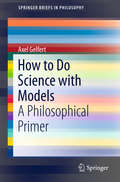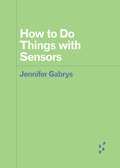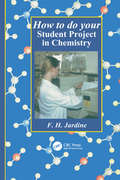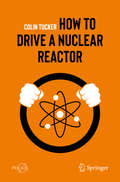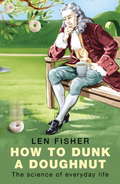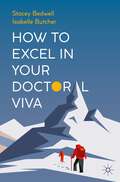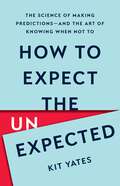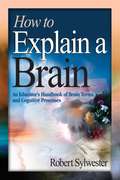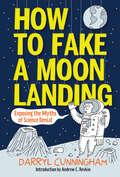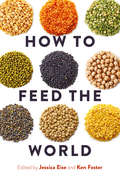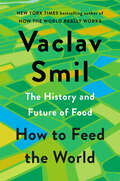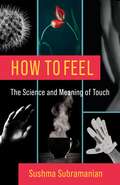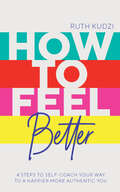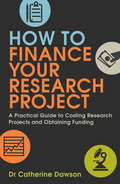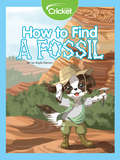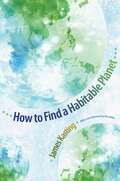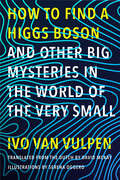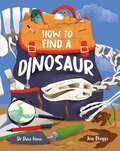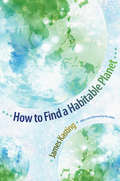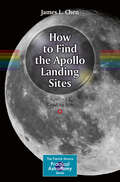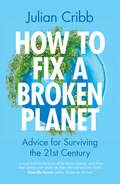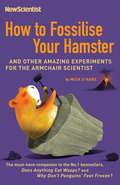- Table View
- List View
How to Do Science with Models
by Axel GelfertTaking scientific practice as its starting point, this book charts the complex territory of models used in science. It examines what scientific models are and what their function is. Reliance on models is pervasive in science, and scientists often need to construct models in order to explain or predict anything of interest at all. The diversity of kinds of models one finds in science - ranging from toy models and scale models to theoretical and mathematical models - has attracted attention not only from scientists, but also from philosophers, sociologists, and historians of science. This has given rise to a wide variety of case studies that look at the different uses to which models have been put in specific scientific contexts. By exploring current debates on the use and building of models via cutting-edge examples drawn from physics and biology, the book provides broad insight into the methodology of modelling in the natural sciences. It pairs specific arguments with introductory material relating to the ontology and the function of models, and provides some historical context to the debates as well as a sketch of general positions in the philosophy of scientific models in the process.
How to Do Things with Sensors (Forerunners: Ideas First)
by Jennifer GabrysAn investigation of how-to guides for sensor technologies Sensors are increasingly common within citizen-sensing and DIY projects, but these devices often require the use of a how-to guide. From online instructional videos for troubleshooting sensor installations to handbooks for using and abusing the Internet of Things, the how-to genres and formats of digital instruction continue to expand and develop. As the how-to proliferates, and instructions unfold through multiple aspects of technoscientific practices, Jennifer Gabrys asks why the how-to has become one of the prevailing genres of the digital. How to Do Things with Sensors explores the ways in which things are made do-able with and through sensors and further considers how worlds are made sense-able and actionable through the instructional mode of citizen-sensing projects.Forerunners: Ideas FirstShort books of thought-in-process scholarship, where intense analysis, questioning, and speculation take the lead
How to do your Student Project in Chemistry
by Fred H. JardineThis book is for undergraduate and diploma chemistry students who are about to begin their project work. Student projects are now an essential part of most undergraduate and diploma chemistry courses in the UK, and are an important component of the later years of chemistry degree courses in Australia, South Africa and New Zealand. The book covers all aspects of project work, from choosing a suitable topic and supervisor to communicating research results effectively. There is advice on the best way to use libraries and on how to gather relevant references. Students are taught how to work safely and effectively, and to present their results in report, seminar or conference poster form. Additionally, the author offers guidance on engaging a keyboard operator, on how to prepare artwork and visual aids, and coaching tips on effective communication. The work is a distillation of the author's many years of experience of guiding students of all abilities to success in their project work. This book should be of interest to second and third year undergraduates and diploma students in chemistry.
How to Drive a Nuclear Reactor (Springer Praxis Books)
by Colin TuckerHave you ever wondered how a nuclear power station works? This lively book will answer that question. It’ll take you on a journey from the science behind nuclear reactors, through their start-up, operation and shutdown. Along the way it covers a bit of the engineering, reactor history, different kinds of reactors and what can go wrong with them. Much of this is seen from the viewpoint of a trainee operator on a Pressurised Water Reactor - the most common type of nuclear reactor in the world. Colin Tucker has spent the last thirty years keeping reactors safe. Join him on a tour that is the next best thing to driving a nuclear reactor yourself!
How to Dunk a Doughnut: Using Science in Everyday Life
by Dr Len FisherLen Fisher is a finalist for the prestigious Global Challenges New Shape prize.Fun, quirky popular science from the winner of an IgNobel Prize for achievements that cannot or should not be reproduced.Science is all around us. In this brilliant, entertaining book, Len Fisher provides scientific answers to familiar questions such as how to boil the perfect egg, how to catch a ball, the physics of sex, and why some vegetables absorb more gravy than others.In doing so, he reveals the world of the scientist - how they think, what they do, and how they go about doing it - proving that even the most commonplace activities can be used as a key to understanding the laws of nature and that experimental science can be fun!
How to Dunk a Doughnut: Using Science in Everyday Life
by Len FisherLen Fisher is a finalist for the prestigious Global Challenges New Shape prize.Fun, quirky popular science from the winner of an IgNobel Prize for achievements that cannot or should not be reproduced.Science is all around us. In this brilliant, entertaining book, Len Fisher provides scientific answers to familiar questions such as how to boil the perfect egg, how to catch a ball, the physics of sex, and why some vegetables absorb more gravy than others.In doing so, he reveals the world of the scientist - how they think, what they do, and how they go about doing it - proving that even the most commonplace activities can be used as a key to understanding the laws of nature and that experimental science can be fun!
How to Excel in Your Doctoral Viva
by Stacey Bedwell Isabelle ButcherHow to excel in your doctoral viva offers an accessible guide to approaching and preparing for a PhD viva examination. The book explains what the viva is, how the process works, and what the purpose of the viva is. It guides the reader through the course of preparing for their viva examination, with chapters focusing on organisation to dealing with viva concerns. Contributions from over 25 academics ranging from critical care to theology provide a unique insight into the experiences of PhD candidates and examiners, and make this book an invaluable resource for students completing PhDs across the sciences.
How to Expect the Unexpected: The Science of Making Predictions—and the Art of Knowing When Not To
by Kit YatesA &“vivid, wide-ranging, and delightful guide&” (bestselling author Tim Harford) for understanding how and why predictions go wrong, with practical tips to give you a better chance of getting them right How can you be 100 percent sure you will win a bet? Why did so many Pompeians stay put while Mount Vesuvius was erupting? Are you more likely to work in a kitchen if your last name is Baker? Ever since the dawn of human civilization, we have been trying to make predictions about what the world has in store for us. For just as long, we have been getting it wrong. In How to Expect the Unexpected, mathematician Kit Yates uncovers the surprising science that undergirds our predictions—and how we can use it to our advantage. From religious oracles to weather forecasters, and from politicians to economists, we are subjected to poor predictions all the time. Synthesizing results from math, biology, psychology, sociology, medicine, economic theory, and physics, Yates provides tools for readers to understand uncertainty and to recognize the cognitive biases that make accurate predictions so hard to come by. This book will teach you how and why predictions go wrong, help you to spot phony forecasts, and give you a better chance of getting your own predictions correct.
How to Explain a Brain: An Educator's Handbook of Brain Terms and Cognitive Processes (1-off Ser.)
by Robert SylwesterNoted author Robert Sylwester offers educators and general readers his own definitions for terms used in the cognitive neurosciences. This unique look into the marvelous brain uses language and descriptions that are accessible to readers, even those with just a limited understanding of biology. Discover how our brain is organized and develops, and how educators can use this emerging understanding of cognition to enhance student learning and the school environment. This ready-reference guide to essential concepts and terms in cognitive neurosciences includes: -Nearly three hundred encyclopedic entries and cross references created to help educators understand key concepts about our brain's organization, development, and learning capabilities -Eleven newly created anatomic models and illustrations that focus on key brain systems and functions -References and recommended print and Internet resources How to Explain a Brain celebrates the brain in all its wonder and is sure to become a reference book of choice for teachers, instructional leaders, and teacher educators.
How to Fake a Moon Landing: Exposing the Myths of Science Denial
by Darryl CunninghamA collection of &“lively, plain-language debunkings of seven cases of quack or fraudulent science and . . . antiscientific bias in general&” (Booklist). Is hydro-fracking safe? Is climate change real? Did the moon landing actually happen? How about evolution: fact or fiction? Author-illustrator Darryl Cunningham looks at these and other hot-button science topics and presents a fact-based, visual assessment of current thinking and research on eight different issues everybody&’s arguing about. His lively storytelling approach incorporates comics, photographs, and diagrams to create substantive but easily accessible reportage. Cunningham&’s distinctive illustrative style shows how information is manipulated by all sides; his easy-to-follow narratives allow readers to draw their own fact-based conclusions. A graphic milestone of investigative journalism! &“Cartoonist Darryl Cunningham . . . is a welcome voice, shedding some much needed light on the darker areas of science and culture. . . . Cunningham does a remarkable job with difficult material and for high school students, just opening their eyes to the world around them, this is a terrific primer.&” —ComicMix
How to Feed the World
by Jessica Eise Dr Ken FosterBy 2050, we will have ten billion mouths to feed in a world profoundly altered by environmental change. How can we meet this challenge? In How to Feed the World, a diverse group of experts from Purdue University break down this crucial question by tackling big issues one-by-one. Covering population, water, land, climate change, technology, food systems, trade, food waste and loss, health, social buy-in, communication, and, lastly, the ultimate challenge of achieving equal access to food, the book reveals a complex web of factors that must be addressed in order to reach global food security.How to Feed the World unites contributors from different perspectives and academic disciplines, ranging from agronomyand hydrology to agricultural economy and communication. Hailing from Germany, the Philippines, the U.S., Ecuador, and beyond, the contributors weave their own life experiences into their chapters, connecting global issues to our tangible, day-to-day existence. Across every chapter, a similar theme emerges: these are not simple problems, yet we canovercome them. Doing so will require cooperation between farmers, scientists, policy makers, consumers, andmany others.The resulting collection is an accessible but wide-ranging look at the modern food system. Readers will not only get asolid grounding in key issues, but be challenged to investigate further and contribute to the paramount effort to feed theworld.
How to Feed the World: The History and Future of Food
by Vaclav Smil"Vaclav Smil is my favorite author."—Bill GatesAn indispensable analysis of how the world really produces and consumes its food—and a scientist's exploration of how we can successfully feed a growing population without killing the planetWe have never had to feed as many people as we do today. And yet, we misunderstand the essentials of where our food really comes from, how our dietary requirements shape us, and why this impacts our planet in drastic ways. As a result, in our economic, political, and everyday choices, we take for granted and fail to prioritize the thing that makes all our lives possible: food.In this ambitious, myth-busting book, Smil investigates many of the burning questions facing the world today: why are some of the world&’s biggest food producers also the countries with the most undernourished populations? Why do we waste so much food and how can we solve that? Could the whole planet go vegan and be healthy? Should it? He explores the global history of food production to understand why we farm some animals and not others, why most of the world&’s calories come from just a few foodstuffs, and how this might change in the future.How to Feed the World is the data-based, rigorously researched guide that offers solutions to our broken global food system.
How to Feel: The Science and Meaning of Touch
by Sushma SubramanianWe are out of touch. Many people fear that we are trapped inside our screens, becoming less in tune with our bodies and losing our connection to the physical world. But the sense of touch has been undervalued since long before the days of digital isolation. Because of deeply rooted beliefs that favor the cerebral over the corporeal, touch is maligned as dirty or sentimental, in contrast with supposedly more elevated modes of perceiving the world.How to Feel explores the scientific, physical, emotional, and cultural aspects of touch, reconnecting us to what is arguably our most important sense. Sushma Subramanian introduces readers to the scientists whose groundbreaking research is underscoring the role of touch in our lives. Through vivid individual stories—a man who lost his sense of touch in his late teens, a woman who experiences touch-emotion synesthesia, her own efforts to become less touch averse—Subramanian explains the science of the somatosensory system and our philosophical beliefs about it. She visits labs that are shaping the textures of objects we use every day, from cereal to synthetic fabrics. The book highlights the growing field of haptics, which is trying to incorporate tactile interactions into devices such as phones that touch us back and prosthetic limbs that can feel. How to Feel offers a new appreciation for a vital but misunderstood sense and how we can use it to live more fully.
How to Feel Better: 4 Steps to Self-Coach Your Way to a Happier More Authentic You
by Ruth KudziWhen we feel broken we look to be fixed, we consume books, have therapy, diet, whatever it takes! BUT true self development is not about being 'fixed' it's about accepting the parts of yourself and then enhancing who we already are.Focusing on evidence-based approaches, Ruth will teach you how to not just read about, but truly integrate personal development work. She'll take you through 4 key questions that encourage both self-reflection and include action-oriented tasks that will help you create sustainable results.1. What do you want? 2. Where are you now? 3. How do you get to where you want to be? 4. How do you stay there?Ruth started our her personal development journey when studying Psychology as she wanted to know what the f**k was wrong with her: she felt that she was different and wanted to see if there was a scientific reason.Using tools she has developed to help train thousands of coaches, Ruth will help you to create a strong self-coaching mindset, helping you to rewire your brain, so that you can adopt new ways of thinking, feeling and behaving. She draws from a variety of disciplines including neuroscience, positive psychology, somatic and energy work to provide a truly unique self-coaching programme that is totally results focused.
How To Finance Your Research Project: A Practical Guide To Costing Research Projects And Obtaining Funding
by Catherine DawsonObtaining research funding can be a long, laborious and stressful process. This book helps ease this process by providing practical advice, useful tips and information about funding databases and funding directories. Covering a wide variety of funding sources such as government, industry and charity, it is suitable for researchers in the UK, US, EU and further afield. Learn how to: ? Find relevant sources of funding ? Produce and justify your budget ? Cost your project ? Complete and submit your application form ? Use ethical funding organizations ? Avoid conflict of interest
How To Finance Your Research Project: A Practical Guide to Costing Research Projects and Obtaining Funding
by Dr Catherine DawsonObtaining research funding can be a long, laborious and stressful process. This book helps ease this process by providing practical advice, useful tips and information about funding databases and funding directories. Covering a wide variety of funding sources such as government, industry and charity, it is suitable for researchers in the UK, US, EU and further afield.Learn how to:· Find relevant sources of funding· Produce and justify your budget· Cost your project· Complete and submit your application form· Use ethical funding organizations· Avoid conflict of interest
How to Find a Fossil
by Amy TaoLearn about the basics of fossil hunting with Tray the Dog, including where to look and good habits to keep while hunting.
How to Find a Habitable Planet (Science Essentials #17)
by James KastingThe amazing science behind the search for Earth-like planetsEver since Carl Sagan first predicted that extraterrestrial civilizations must number in the millions, the search for life on other planets has gripped our imagination. Is Earth so rare that advanced life forms like us—or even the simplest biological organisms—are unique to the universe? How to Find a Habitable Planet describes how scientists are testing Sagan's prediction, and demonstrates why Earth may not be so rare after all.James Kasting has worked closely with NASA in its mission to detect habitable worlds outside our solar system, and in this book he introduces readers to the advanced methodologies being used in this extraordinary quest. He addresses the compelling questions that planetary scientists grapple with today: What exactly makes a planet habitable? What are the signatures of life astronomers should look for when they scan the heavens for habitable worlds? In providing answers, Kasting explains why Earth has remained habitable despite a substantial rise in solar luminosity over time, and why our neighbors, Venus and Mars, haven't. If other Earth-sized planets endowed with enough water and carbon are out there, he argues, chances are good that some of those planets sustain life. Kasting describes the efforts under way to find them, and predicts that future discoveries will profoundly alter our view of the universe and our place in it.This book is a must-read for anyone who has ever dreamed of finding other planets like ours—and perhaps even life like ours—in the cosmos. In a new afterword, Kasting presents some recent breakthroughs in the search for exoplanets and discusses the challenges facing space programs in the near future.
How to Find a Higgs Boson—and Other Big Mysteries in the World of the Very Small
by Ivo van VulpenThe history of particle physics, the hunt for the most elusive particle, and the fundamental questions the search has inspired How did physicists combine talent and technology to discover the Higgs boson, the last piece in our inventory of the subatomic world? How did the Higgs change our understanding of the universe? And now, nearly a decade after its detection, what comes next? Answering these questions, Ivo van Vulpen—a CERN particle physicist and member of the team behind the detection—invites us on a journey to the frontiers of our knowledge. Enjoy van Vulpen&’s accessible explanation of the history of particle physics and of concepts like quantum mechanics and relativity—and ponder his inquiries regarding the search for new particles (to explain dark matter), a new force (to combine the existing fundamental forces), and new phenomena (undiscovered dimensions of space). This is a lively account of work at the world&’s highest-energy particle accelerator, with inspiring personal reflections on humanity&’s discoveries deeper and deeper into the world of the very small.
How To Find A Dinosaur
by Dr. Dave HoneDinosaurs went extinct 66 million years ago, but their fossils can still be found hidden beneath the earth - if you know how to look for them. Learn how to be a dinosaur detective and join a team at every stage of the process, from planning an expedition and digging for clues to safely transporting any finds back for study. Meet the palaeontologists and geologists who cross continents to uncover underground fossils and the researchers and palaeoartists who work out the stories from the bones.We're going on a dinosaur hunt... what will we find?Written by an expert palaeontologist with experience of discovering new species, each stage in the process is verified and a perfect resource for fossil hunters aged 7 and up.
How To Find A Habitable Planet (Science Essentials)
by James KastingTukufu Zuberi offers a concise account of the historical connections between the development of the idea of race and the birth of social statistics. Zuberi describes the ways race-differentiated data is misinterpreted in the social sciences and asks searching questions about the ways racial statistics are used. He argues that statistical analysis can and must be deracialized, and that this deracialization is essential to the goal of achieving social justice for all.
How to Find the Apollo Landing Sites
by James L. ChenThis book is for anyone who wants to be able to connect the history of lunar exploration to the Moon visible above. It addresses what Apollo equipment and experiments were left behind and what the Apollo landings sites look like now. Each Apollo mission is examined in detail, with photos that progressively zoom-in to guide the reader in locating the Apollo landing sites. Guided by official NASA photographs from the Lunar Reconnaissance Orbiter and the original Apollo missions, the reader can view the Moon with a new appreciation of the accomplishment of landing astronauts on its surface. Countless people have gazed at the Moon in the night sky knowing the successes of the Apollo Program in landing men on the Moon. After the information in this guide, casual and serious observers can actually point out where the Apollo landings occurred as well as knowing why those sites were chosen.
How to Fix a Broken Planet: Advice for Surviving the 21st Century
by Julian CribbDo you want to help save human civilisation? If so, this book is for you. How to Fix a Broken Planet describes the ten catastrophic risks that menace human civilisation and our planet, and what we can all do to overcome or mitigate them. It explains what must be done globally to avert each megathreat, and what each of us can do in our own lives to help preserve a habitable world. It offers the first truly integrated world plan-of-action for a more sustainable human society - and fresh hope. A must-read for anyone seeking sound practical advice on what citizens, governments, companies, and community groups can do to safeguard our future.
How to Fossilise Your Hamster: And other amazing experiments for the armchair scientist
by New ScientistHow can you measure the speed of light with chocolate and a microwave? Why do yo-yos yo-yo? Why does urine smell so peculiar after eating asparagus (includes helpful recipe)? How long does it take to digest different types of food? What is going on when you drop mentos in to cola? 100 wonderful, intriguing and entertaining scientific experiments which show scientific principles first hand - this is science at its most popular.
How to Fossilise Your Hamster: And other amazing experiments for the armchair scientist
by New ScientistHow can you measure the speed of light with chocolate and a microwave? Why do yo-yos yo-yo? Why does urine smell so peculiar after eating asparagus (includes helpful recipe)? How long does it take to digest different types of food? What is going on when you drop mentos in to cola? 100 wonderful, intriguing and entertaining scientific experiments which show scientific principles first hand - this is science at its most popular.
